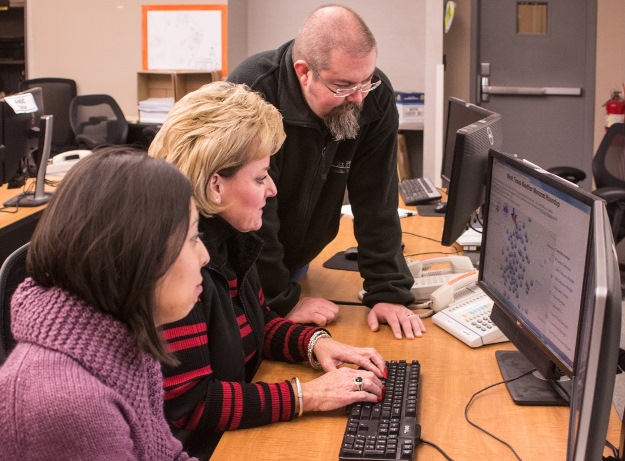CNS securing success across both sites
Safeguards, Security and Emergency Services integrated, consolidated and standardized processes at Pantex and Y-12 in 2015. According to Gary Wisdom, SS&ES senior director at Pantex, “The exchange of information has been our greatest effort and our most valuable success. Integrating our knowledge, purpose and strategic initiatives can ultimately provide the greatest returns.”

Pantex Emergency Services members (from left) Maribel Martinez, Brenda Graham and Greg Roddahl learn how to use the Emergency Management Information System, or EMInS.
In many cases, the formalization and documentation of long‑established informal processes were major accomplishments. For example, in June 2015, the National Nuclear Security Administration Production Office approved consolidated rules of engagement and hostile intent policies for unmanned aerial systems at both CNS sites.
In July, essential elements terminology was standardized, and the organization decided to proceed with incorporating all governing documents into a single Requirement Management System, which assists with consolidating the flow down of Department of Energy requirements into site‑specific documents.
The enterprise infrastructure to facilitate and support these efforts is integral to their success. Training, Supply Chain Management, Document Control and other organizations must be integrated so that they can support integration at lower levels. Representatives from SS&ES, Transformation and Supply Chain Management developed a logistics plan to make it easier for SS&ES employees to get what they need to do their work on time and cost effectively.
“If we can reduce the time spent completing repetitive purchase paperwork, reduce the time it takes to get the items and services we need, that’s a big plus for everyone,” explained Brian Deorocki of SS&ES Integration Management. Items needed at both sites may be purchased in bulk, improving employee effectiveness and reducing costs.
The logistics plan simplifies these repetitive and multi‑year procurements of specialized supplies, parts and equipment, as well as maintenance, service and repair contracts. Protective Force personnel at both sites worked together to develop a statement of work for a firearms maintenance capability at Anniston Army Depot. The depot possesses machines, parts and tools to renovate and refurbish military firearm systems and restore them to current military specifications, a capability not available at Pantex or Y-12. Both sites have provided additional statements of work for other site‑specific weapons and have coordinated with Supply Chain Management for an integrated ammunition procurement process.
During the year, Emergency Services leadership developed a common vision for the Enterprise Emergency Services organization and shared processes. Y-12’s Exercise Builder software was implemented at Pantex, along with the Communicator NXT technology and the first phase of the Emergency Management Information Notification System. Y-12 personnel offered guidance and training on each system throughout implementation.
Personnel from the sister site served as evaluators, leading to valuable discussions afterwards where processes were compared and a common balance was agreed upon.
“We continue developing common approaches to various ways of reporting and doing business across both sites, but we also realize we need to enhance our performance in terms of communications, leadership, ethics, teamwork and job satisfaction,” Wisdom said.
SS&ES teams continue integrating the Pantex and Y‑12 programs. Ken Freeman, SS&ES vice president, said, “The integration effort has been challenging, but we are very pleased with the work our employees are accomplishing. Through their continued collaborative and cooperative efforts, we anticipate having even greater success in FY 2016.”
